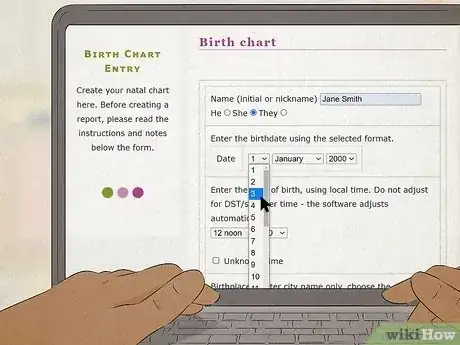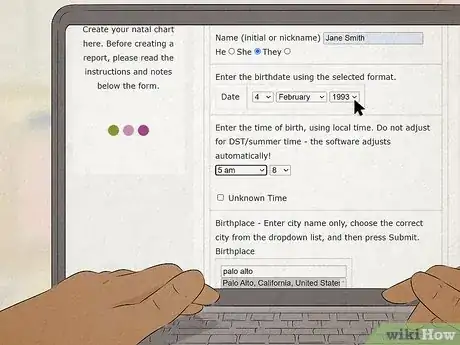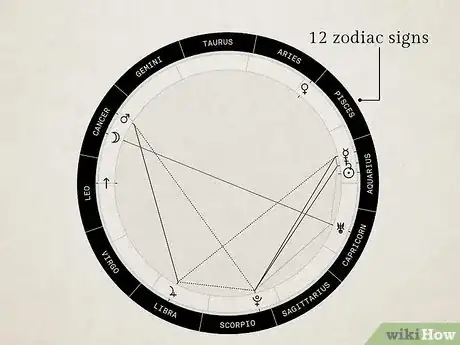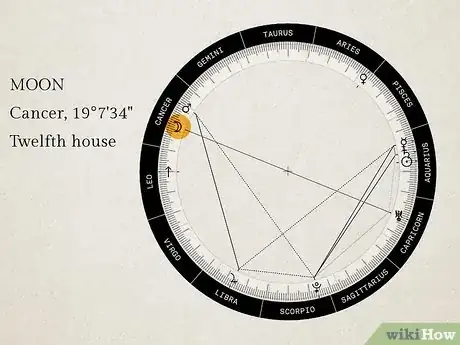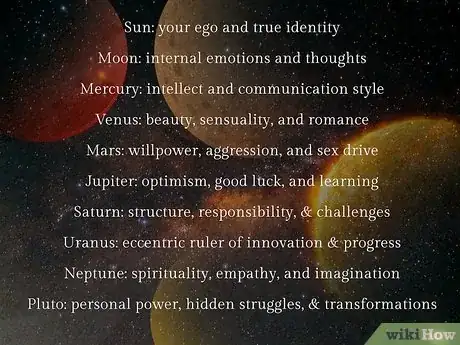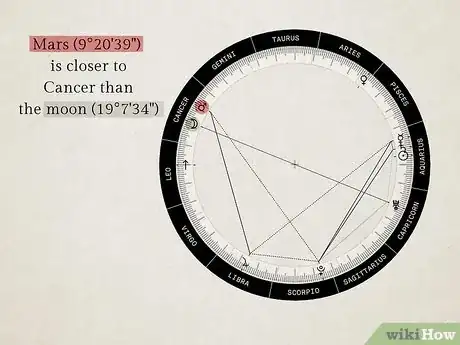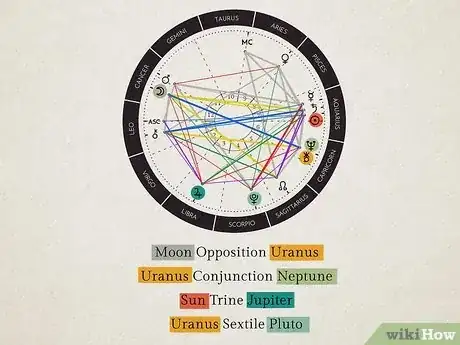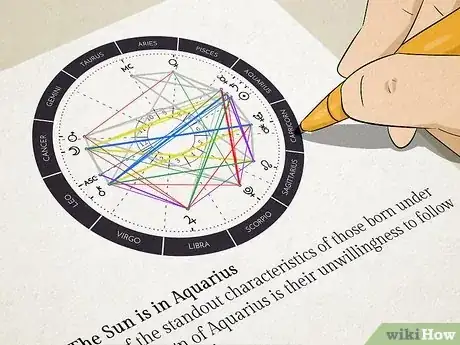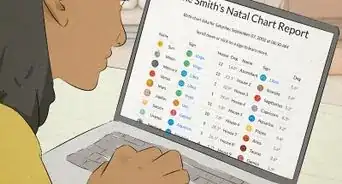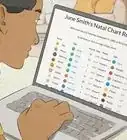This article was co-authored by Angel Eyedealism and by wikiHow staff writer, Dan Hickey. Angel Eyedealism is an Astrologer and Performance Artist based in the Lower East Side of Manhattan. With nearly three decades of astrology experience, Angel specializes in relocation astrology and astrocartography. Eyedealism has been featured in numerous media outlets such as Vogue, Cosmopolitan, The Atlantic, The Washington Post, Refinery29, NBC, MTV, Showtime, and Bravo. Angel aims to help others through a straightforward, kind, and humorous astrological lens, utilizing her entertainment and singing skills for performance art astrology readings.
This article has been viewed 50,012 times.
You know which zodiac signs your planets occupy, but is that the end of the story? It turns out that the degree of your planets—their exact placement within a zodiac sign or house—has a big influence on their relationship to each other (and their power in your life). With an accurate natal chart and a little bit of geometry, it’s easy to determine your planets’ degrees and interpret their placements. We’ve put together a comprehensive guide to creating your natal chart, checking your planets’ degrees, and reading their meanings. If you’re ready to explore your planet placement, read on!
This article is based on an interview with our astrologer and performance artist, Angel Eyedealism. Check out the full interview here.
Steps
Creating Your Natal Chart
-
1Collect all of the necessary information to create your natal (birth) chart. Your natal chart is a snapshot of the sky at the exact moment you were born. It tells you the location and position of all the zodiac constellations, houses, and planets that are used to interpret your chart. A chart is necessary to determine the degrees of your planets. To make an accurate chart, you need the following information:
- Your date of birth (day, month, and year).
- Your exact time of birth (check your birth certificate or ask your parents if you’re unsure. If you can’t find this information, make an estimate or contact a local records office to ask for a birth certificate duplicate).
- Your place of birth (town, state or province, and country).
-
2Find an astrology website that generates natal charts. A quick search will show many free, high-quality websites that generate accurate natal charts. Some may require you to create an account to view all of your placements and interpretations, but many will create a detailed chart with no strings attached.[1] Try making a chart with one of these sites:
- Astrology.com
- Astrolabe
- Cafe Astrology
Advertisement -
3Enter your birth information to generate your chart. Navigate to the free reading or free chart section of the website. If you can’t spot it easily, try searching “birth chart” or “natal chart” to pull up the right page. Enter your birth date, time, and place in the corresponding fields and voila! You have your natal chart.
-
4Adjust the settings or enter additional information as necessary. Some sites might ask for additional information or settings besides your birth details. These won’t affect the placement of your planets, but might influence the interpretation of your chart. Some extra options you might run into include:
- Entering your gender (many sites include non-binary or “prefer not to say” options).
- Choosing a circular chart or a table (most sites default to a circular chart, which is easier to visualize and read for beginners).
- Selecting a house system. If you’re new to chart reading, opt for Whole-Sign (each house will line up exactly with a zodiac sign and make for an easy-to-read chart). If you have a preferred system, like Placidus, Koch, or Porphyry, go ahead and choose that.
Reading Planetary Degrees
-
1Look at the 12 zodiac signs encircling the outside of your chart. A circle is 360 degrees, and each zodiac sign takes up 30 degrees (one 12th of the circle). Each sign begins at 0 degrees and grows to 29 degrees going counterclockwise. Every time you hit 30, a new sign begins.[2]
- Signs can also be split into 3 decans, or sections that are 10 degrees wide. 0-9 degrees of a sign is the 1st decan, 10-19 degrees is the 2nd, and 20-29 degrees is the 3rd.
-
2Find the degree markings located near the zodiac sign ring. Not all chart generators will show single degree markings—some might show degrees in multiple of 10 (decans), or of 5. In these cases, you will estimate where a specific number like 17 degrees would be based on the provided markings.
- Not all charts will show degree markings. If this happens, remember that degrees grow from 0 to 29 counterclockwise and make your best estimate.
- Some charts might indicate minutes along with degrees if a planet is between degrees. There are 60 minutes in 1 degree.
- If you chose a Whole-Sign house system, each house will be 30 degrees wide and correspond exactly to a zodiac sign. Other systems will show houses overlapping with signs at differing widths.
-
3Locate the planets on your chart. The sun, moon, and planets—Mercury, Venus, Mars, Jupiter, Saturn, Uranus, Neptune, and Pluto—are represented by glyphs placed somewhere on your chart (in astrology, glyphs are small symbols that denote planets and constellations). Each heavenly body falls within a zodiac sign and house.
- Most chart generators will include a key to help you pair a planet with its glyph.
- Some signs and houses might have multiple planets in them while others have none. This is totally normal—every person’s chart has varying planet placements, which is what makes your chart unique to you!
-
4Compare the planet’s position to the degree markings on the zodiac wheel. If the chart notates planets close to the zodiac ring, you can probably eyeball the planet’s degree accurately. If not, grab a straight edge (like a ruler) and make a straight line from the planet to the edge of the chart. Wherever this line lands indicates the degree of the planet inside a given zodiac sign. For example:
- If Mercury is just barely inside the Gemini sign at 1 or 2 degrees, you’d say that Mercury is 2 degrees Gemini.
- If Jupiter appears right in the middle of Scorpio, you’d estimate that Jupiter is about 15 degrees Scorpio.
- If Pluto is about to exit Sagittarius, you’d say Pluto is 28 degrees Sagittarius.
Interpreting Planetary Degrees
-
1Get familiar with the characteristics of each planet. Each celestial object governs different aspects of your life and personality, and knowing how they influence you is critical to interpreting their degrees and placement.[3] Here’s a quick run-down:
- The sun represents your ego and true identity.
- The moon influences your internal emotions and thoughts.
- Mercury governs your intellect and communication style.
- Venus rules beauty, sensuality, and romance.
- Mars represents willpower, aggression, and sex drive.
- Jupiter is the king of optimism, good luck, and learning.
- Saturn is the planet of structure, responsibility, and challenges.
- Uranus is the eccentric ruler of innovation and progress.
- Neptune influences your spirituality, empathy, and imagination.
- Pluto embodies your personal power, hidden struggles, and transformations.
-
2Look at how “deep” into a zodiac sign the planets are. In general, planets near the edges of a sign (about 0-2 degrees or 27-29 degrees) interact with the sign weakly or have a delayed influence. Planets closer to the middle have a much stronger interaction with the sign and their influence on your life is more clear.
-
3Look for major aspects in the planetary positions. Aspects are the angles the planets make with each other as they traverse the 360 degrees of the sky. Think of these mathematical angles as the way the planets communicate or interact with each other. There are 5 major aspects that have obvious and profound influence over your life.[4] To sum them up briefly:
- A conjunction happens when 2 planets are within a few degrees of each other. When this happens, they blend their energy together.
- A sextile happens when planets are about 60 degrees (2 zodiac signs) apart. Planets in this aspect work together harmoniously, often bringing about a good mood.
- When 2 planets are square (90 degrees or 3 zodiac signs apart), they’re in opposition to each other. Expect tension and conflict between the planets’ energies.
- When 2 planets are trine (about 120 degrees or 4 zodiac signs apart), they work together to bring you luck and opportunity.
- When planets are in opposition, they are 180 degrees apart (directly across the circle from each other, or 6 signs apart). Opposition can bring balance between the planets’ energies, or create obstacles.
-
4Measure any minor aspects between the planets’ positions. Minor aspects are more subtle and nuanced than major aspects, but can still tell you a lot about your chart and the planets’ influence on your life. Keep an eye out for the following relationships:
- A quincunx aspect occurs when planets are 150 degrees apart. Tension arises between the planets because they can’t balance their energies, and one planet will eventually overcome the other. This is the most important of the minor aspects.
- When planets are 72 degrees apart, they form a quintile. Quintile planets can give you a boost in ambition and creativity.
- A semi-sextile relationship happens when planets are 30 degrees apart. Semi-sextile planets struggle to understand each other, but have the opportunity to learn how to work together.
- A semi-square relationship (45 degrees apart) isn’t as tough to handle as a square, but will still result in subtle friction.
- When planets are 135 degrees apart, they form a sesquiquadrate aspect. These planets have no interest in working together and result in stubborn feelings.
- When planets are bi-quintile (144 degrees apart), they have a favorable relationship resulting in inventiveness and originality.
- A septile happens when 2 planets are one seventh of a circle apart (exactly 51 degrees and 25 minutes apart). 7 is a divine number, and planets in this aspect can awaken new spiritual or artistic insights for you.
-
5Use the aspects and planetary characteristics to interpret your chart. The planets, zodiac signs, and their aspects combine to create the unique characteristics of an individual. With all of these varying elements, there’s no one “correct” analysis. Go with whatever interpretation resonates with you the most! Here are some example interpretations you could make based on planetary degrees:
- If your Mercury is 15 degrees Gemini, you’ll feel the full force of Gemini in your communication style—talkative, fast-paced, and witty—since the planet is right in the middle of the sign.
- Say your ego-governing sun is septile with Jupiter, the planet of optimism and learning. You might feel new inspiration or insight in the form of personal growth, expansion, or learning.
- Imagine Venus and Mars are in conjunction at 10 degrees Sagittarius. When the planets of sensuality and willpower blend their energies, you might feel intense passion and commitment in your love life. In the adventurous and fiery sign Sagittarius, this passion could manifest as romantic spontaneity or a robust and fun sex life.


